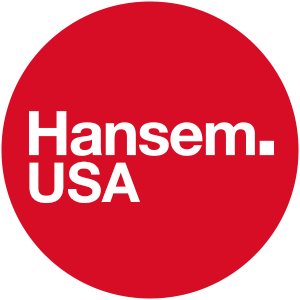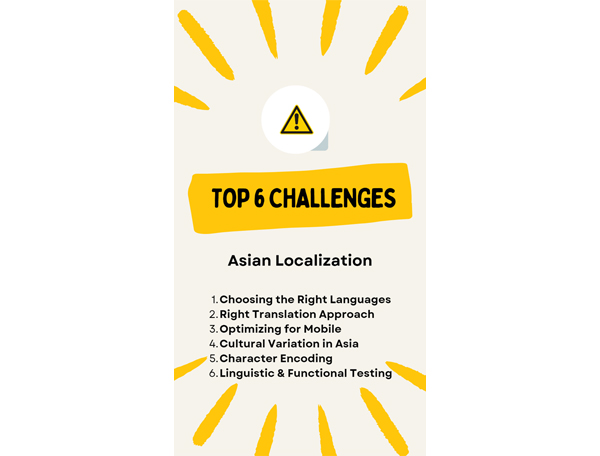

Localization


Translation fails can make great memes — but while the internet loves a good joke, business stories aren’t usually on the funny side when inadvertent language blunders happen. And when it comes to that, the Asian market is very likely to take the crown in terms of the frequency of translation errors.
Yet for global companies, Asian localization is a must — and if you want to do it, being aware of the challenges is essential. Here’s our perspective on this, based on 34 years of Asian localization.
There are more than 4.3 billion people in the Asia-Pacific (APAC) region. To say it’s a massive market (and an even bigger opportunity) would be an equally massive understatement.
Yet — if you want to break into the APAC market, you must translate your content and adapt your product for each of the countries you are targeting there.
It’s a lot to keep up with, but not impossible, and with a lot of potential for reward. The Asian market is primed for growth:
Localizing your product and content opens you up to a massive potential customer pool. You have all the reasons to localize. And none not to…except for how tricky it is.
Complexities abound. Not only do people in the region speak more than 3,000 languages (!), but they also have multiple language variations and, culturally-specific preferences, dialects, and sensitivities that could have a tremendous impact on your business and how well it does there.
Also, Asian localization is trickier than localizing in most Western languages — so the more you know, and the more you can prepare ahead, the more likely it is you’ll land on your feet in APAC.

Here are some of the main challenges you might have to face when you start localizing for the Asian market:
There are 49 countries in Asia representing very different cultures and languages. Even within the same country, you will often encounter multiple languages. For example, there are 302 individual ones in China. While localizing for all of them may not be necessary, being aware of the variations and sensitivities is essential.
You also need to know that there are 2 types of written Chinese: traditional Chinese for Taiwan and Hong Kong, and simplified Chinese used in mainland China and Singapore. So, choose your language carefully, based on your specific target audience.
Knowing the language is one thing, but word-for-word (literal) translations can end up as disasters that are completely off the mark in terms of meaning and cultural sensitivity. As such, it’s crucial to find a translator who is not only fluent in the language but also has an intimate understanding of the culture and context in which the translation will be used.
What you need, more than basic translation is an approach called transcreation. This process of adapting content for a specific audience and culture so that it maintains the intent and emotion behind the original is a large step beyond just getting the words right. This way, you make sure your message gets across correctly — and your product or service isn’t seen as culturally insensitive.
Asia is mobile-first: Fast internet speed and a high rate of mobile adoption make the Asian market far more likely to experience the internet on a mobile-first rather than a desktop. In fact, studies show that, except for Japan, mobile eCommerce amounted to more than 50% of all sales in the APAC region. More even, it is estimated that the number will grow much more in some countries, like South Korea, where predictions say that, by 2026, 77% of all eCommerce sales will happen on mobile.)
As such, it’s essential to ensure that your website and all digital content are optimized for mobile devices. Apps need to be easy to use, content needs to display properly, and images need to load fast. Otherwise, you risk losing out on potential customers who will quickly turn away from an unoptimized site or product.
Asian cultures can differ greatly in terms of communication styles, collectivism, respect for hierarchy, religious beliefs, social norms, buying behaviors, and brand preferences (to name a few). When localizing for each market, you’ll need to consider the significant differences between them and account for them appropriately.
For example:
And these are just a couple of examples of the variations you will encounter in the Asian market. Localizing for Asia doesn’t mean you pick the top 2-3 languages (Japanese, Korean, and Chinese probably). Instead, you need to develop a localization strategy that allows for country-specific variations and nuances, and a language set that covers your market.
Character encoding is an essential factor to consider when localizing for markets that use non-Latin writing systems, such as Chinese, Japanese, and Korean. These languages require specific encoding to ensure proper display on websites and digital platforms. Failure to account for this can result in broken or unreadable text, which can damage your brand’s reputation and credibility.
Plus, localizing for Asian markets involves addressing technical hurdles like managing text expansion due to translation from English to CJK (Chinese, Japanese, Korean) requiring more space. Proper font support and encoding are essential to accommodate specific Asian scripts.
Once you have localized a website or software, you need to do linguistic and functional testing to make sure your product works and looks as it should for that target market. The difference between the two is that linguistic testing ensures that all the characters within the content are displayed correctly, while functional testing looks for features that were broken in the localization process
Inadequate testing can render your website or your software app unusable — and that will reflect negatively on your brand and give a terrible user experience. This is why it’s crucial to have native speakers in the target markets test your localized content before releasing it publicly.
Some localization scandals are funny. Some are downright outrageous. In all cases, however, the effects are similar on local markets: ruined brand reputation and underwhelming sales.
For example, one infamous slogan error occurred with Pepsi’s “Brings you back to life” slogan, which, when translated into Chinese, mistakenly promised to “Brings Your Ancestors Back from the Grave” – a claim that is, needless to say, appealing (maybe?) but highly implausible.
In a similar vein, KFC’s effort to enchant the Chinese market in the 1980s with its famous “Finger-lickin’ good” slogan took an unappetizing turn, translating quite literally to “Eat your fingers off.” Not exactly what you’d want at a family dinner, right?
Translation blunders happen the other way around too – when Asian brands try to localize in English. For example, Iranian company Paxam launched their laundry soap in the US, but mistranslated “Snow” into “Barf.”

Good localization is about much more than just translating words. It is about knowing the local culture, customs, and preferences to create content that is culturally appropriate and resonant with the target audience. And with Asian languages, there are also a lot of technical complexities that you need to understand, plan for, and budget to handle.
Don’t think twice before you decide to partner with a professional localization service — it can make or break your entry in the APAC region.
And if you need someone, Hansem Global is here for you: contact us and take the first step towards a successful localization strategy in Asia.
Hansem Global is an ISO Certified and globally recognized language service provider. Since 1990, Hansem Global has been a leading language service company in Asia and helping the world’s top companies to excel in the global marketplace. Thanks to the local production centers in Asia along with a solid global language network, Hansem Global offers a full list of major languages in the world. Contact us for your language needs!
 Transforming B2C Sales Training with Gamification
04.14.2024
Transforming B2C Sales Training with Gamification
04.14.2024
 The Impact of Localization on Salesforce’s Success with Hansem Global
04.07.2024
The Impact of Localization on Salesforce’s Success with Hansem Global
04.07.2024
 Mastering Right-to-Left (RTL) Language Localization: Avoid the Top 5 Desktop Publishing (DTP) Mistakes for Global Success
04.03.2024
Mastering Right-to-Left (RTL) Language Localization: Avoid the Top 5 Desktop Publishing (DTP) Mistakes for Global Success
04.03.2024